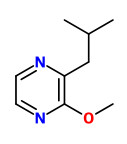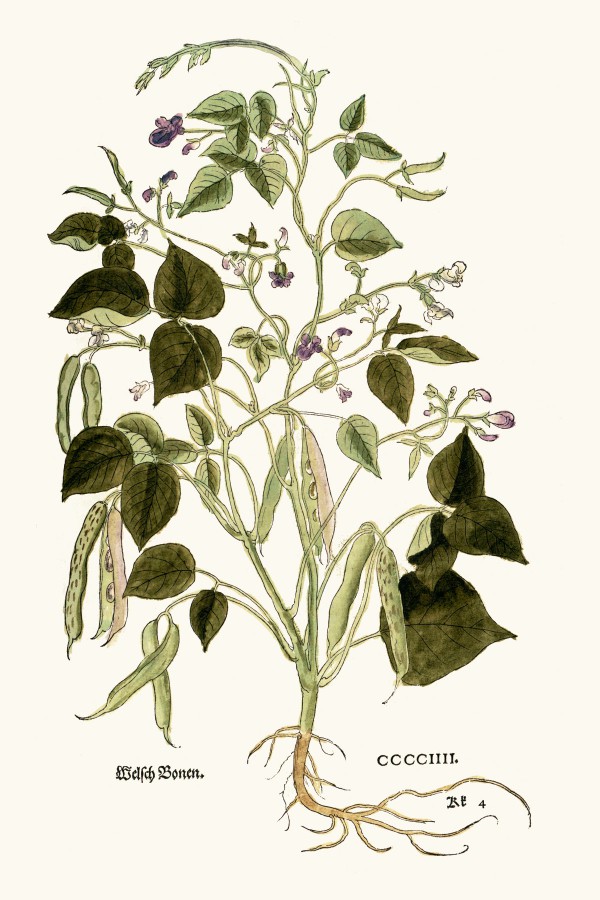Dies ist eine alte Version des Dokuments!
Phaseolus vulgaris L. - syn.Phaseolus nanus L. - Fabaceae
common bean, green bean, French bean, Gartenbohne, Grüne Bohne
Annual herb, twining or suberect, up to 60cm tall, native to Central America, cultivated widely; stems pubescent or glabrescent when old; leaves alternat, divided into three leaflets, leaflets broadly ovate or obovate-rhombic, pubescent, base rounded or broadly cuneate, margin entire, apex acuminate; calyx cup-shaped, 3-4 mm, corolla white, yellow, violet, or red, 9-12mm wide; legumes linear-oblong, 10-15cm long, slightly curved; seeds 4-10.
http://www.efloras.org/florataxon.aspx?flora_id=2&taxon_id=200012279
https://en.wikipedia.org/wiki/Phaseolus_vulgaris
By headspace examination of the salt-saturated juice from fresh whole pods, mainly 2-isobutyl-3-methoxypyrazine, but also 2-isopropyl-3-methoxypyrazine, and some 2-sec-butyl-3-methoxypyrazine, have been found important olfactory (green earthy vegetable-like) volatile components of French bean.
[Murray, Keith E., and Frank B. Whitfield. „The occurrence of 3‐alkyl‐2‐methoxypyrazines in raw vegetables.“ Journal of the Science of Food and Agriculture 26.7 (1975): 973-986]
 2-isobutyl-3-methoxypyrazine (3-isobutyl-2-methoxypyrazine)
2-isobutyl-3-methoxypyrazine (3-isobutyl-2-methoxypyrazine)
„By application of aroma extract dilution analysis (AEDA) to an extract prepared from raw French beans, 25 odour-active compounds with flavour dilution (FD) factors in the range 4-2048 were detected and subsequently identified. Among them, (Z)-3-hexenal (green, leaf-like), 1-octene-3-one (mushroom-like), 3-isobutyl-2-methoxypyrazine (earthy, beany) and (E,Z)-2,6-nonadienal (cucumber-like) showed the highest FD factors. In an extract prepared from the same amount of cooked beans, 3-isobutyl-2-methoxypyrazine was identified as the most potent odorant, followed by 1,5-(Z)-octadiene-3-one (geranium-like), 3-isopropyl-2-methoxypyrazine (earthy, beany), 3-(methylthio)propanal (methional; cooked potato), 4,5-epoxy-(E)-2-decenal (metallic) and an unknown compound (FD 256) with a smell of geranium leaves. A decrease in (Z)-3-hexenal and 1-pentene-3-one (etheral, pungent) and an increase in methional during cooking were shown to be mainly responsible for the flavour changes induced by cooking the beans.“
[Hinterholzer, Andrea, Teresa Lemos, and Peter Schieberle. „Identification of the key odorants in raw French beans and changes during cooking.“ Zeitschrift für Lebensmitteluntersuchung und-Forschung A 207.3 (1998): 219-222]

Phaseolus vulgaris L.; L. Fuchs, New Kreüterbuch, t.404 (1543)
http://botanicalillustrations.org/species.php?id_species=776625&SID=0&size=1

Phaseolus vulgaris pods; Snijboon peulen (ndl.), Schnittbohnen (dt.)
CC BY-SA 3.0, Author Rasbak Wikimedia Commons
